NCERT Solutions for Class 10 Science Chapter 11 Human Eye and Colourful WorldYou can find all the information that you need about chapter 11 of science for class 10 in this page. Candidates will be able to achieve a high mark on the class 10 board exam by studying the NCERT class 10 science chapter 11 notes. Additionally, given this unit falls under the topic of Physics, having a solid understanding of the human eye and colourful world class 10 science NCERT solution will lay a strong basis for passing other competitive examinations. 
Every question in the Human Eye and Colorful World exercises has an answer as well as a thorough, step-by-step solution for the student's benefit. The solution provided here will help you to know every thing about the class 10 science chapter 11 Human Eye And Colourful World. With help of these students can secure a decent marks in their board exams. NCERT Solutions for Class 10 Science Chapter 11 Human Eye and Colourful WorldPage Number: 190Question 1: What is meant by power of accommodation of the eye? Answer: The power of accommodation of eye means, how well it can concentrate on both nearby and distant things. Question 2: A person with a myopic eye cannot see objects beyond 1.2m distinctly. What should be the type of the corrective lens used to restore proper vision? Answer: In case of myopic person the image is formed in front of the retina so the rays needs to be diverged which can be done by using concave lens. Question 3: What is the far point and near point of the human eye with normal vision ? Answer: 25 cm is the normal near point for the human eye with normal vision and the farthest point is infinity. Question 4: A student has difficulty reading the blackboard while sitting in the last row. What could be the defect the child is suffering from? How can it be corrected? Answer: The child is suffering from myopia because in case of myopia image is formed before retina which appears blurry. The child should use concave lens of suitable focal length so that the light could be diverged and image will be formed on the walls of the retina. NCERT Solutions for Class 10 Science Chapter 11 Human Eye and Colourful WorldQuestion 1: The human eye can focus objects at different distances by adjusting the focal length of the eye lens. This is due to
Answer: b.) Accommodation Question 2: The human eye forms the image of an object at its
Answer: d.) Retina Question 3: The least distance of distinct vision for a young adult with normal vision is about
Answer: c.) 25 cm Question 4: The change in focal length of an eye lens is caused by the action of the
Answer: c.) Ciliary muscles Question 5: A person needs a lens of power -5.5 dioptres for correcting his distant vision. For correcting his near vision he needs a lens of power +1.5 dioptre. What is the focal length of the lens required for correcting (i) distant vision, and (ii) near vision? Solution: 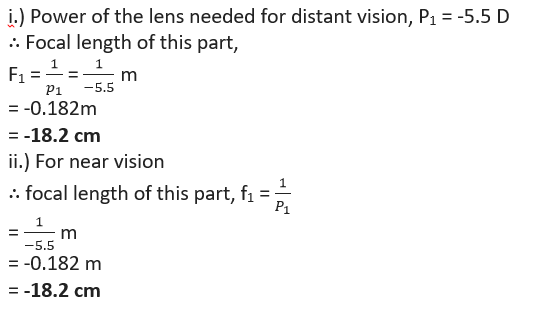
Question 6: The far point of a myopic person is 80 cm in front of the eye. What is the nature and power of the lens required to correct the problem? Solution: The corrective lens should make infinity-focused objects visible at a distance. We know that for such type of case the object is at infinity which means that , u is ∞. Distance of the defected eye from the lens, v = -80 cm Thus by lens formula, 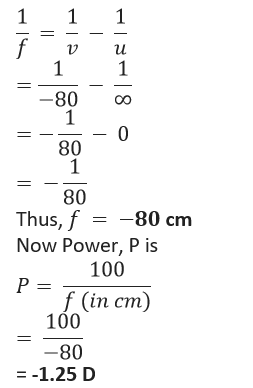
The negative sign is a remark for the type of lens used. Here the sign is negative so its concave lens. Question 7: Make a diagram to show how hypermetropia is corrected. The near point of a hypermetropic eye is 1 m. What is the power of the lens required to correct the defect ? Assume that the near point of the normal eye is 25 cm. Solution: i.) The hypermetropia eye's near point N is further away than the normal near point N. 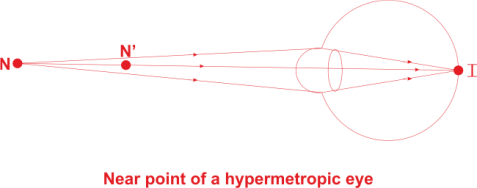
ii.) The image of a near object situated at normal near point N (at 25 cm) is created behind the retina in a hypermetropic eye. 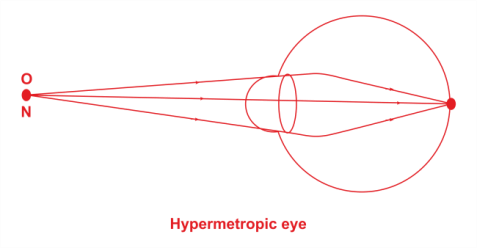
iii.) Correction of hypermetropia : At the near point N' of this eye, the convex lens creates a virtual picture of the object (lying at normal near point N). 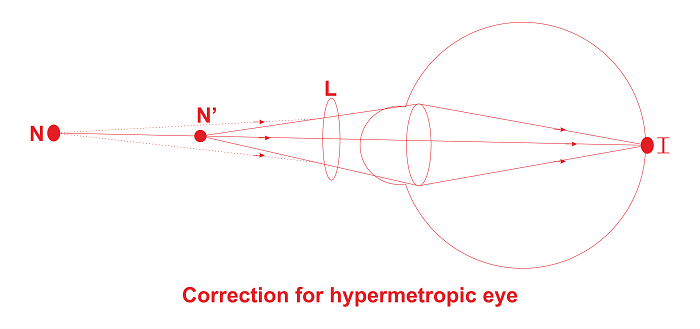
The object must create a virtual image at 1 m or 100 cm when it is placed 25 cm from the corrective lens. Therefore, u = -25 cm, v = 10 cm By lens formula, 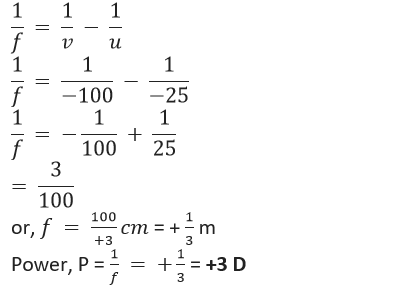
The positive sign shows that the image used is a convex lens. Question 8: Why is a normal eye not able to see clearly the objects placed closer than 25 cm? Answer: The ability of the ciliary muscles to widen the eye lens is lost when an item is closer than 25 cm, making it impossible to concentrate on the retina and causing it to look hazy to the eye. This is demonstrated in the provided image. 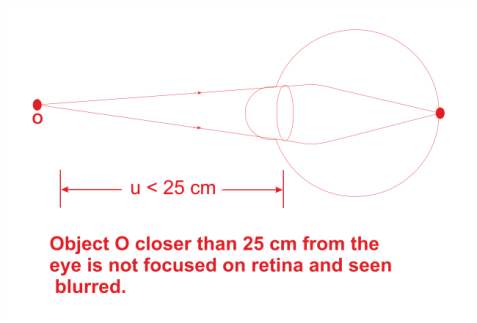
Question 9: What happens to the image distance in the eye when we increase the distance of an object from the eye? Answer: A typical eye's lens creates images of objects at different distances on the same retina. As a result, the picture distance in the eye does not change. Question 10: Why do stars twinkle? Answer: As a result of atmospheric refraction, stars appear to twinkle. After entering the earth's atmosphere, starlight is continuously refracted until it reaches the planet's surface. The stars are far off. Thus, they are the light's single point source. The apparent position of stars changes as the starlight's path does, and the amount of starlight that reaches the eye continues to twinkle. Because of this, a star may appear bright or dim at different times, which is the result of twinkling. Question 11: Explain why the planets do not twinkle? Answer: Planets can be considered to be the main sources of light since they are far closer to us than stars are. If a planet is viewed as a collection of a very large number of point sources of light, the average change in the amount of light entering the eye from all of these sources is zero. The sparkling effect is thus gone. Question 12: Why does the sun appear reddish early in the morning? Answer: Sunlight passes through a variety of denser air layers in the earth's atmosphere before it reaches our sight near the horizon. The bulk of blue and short-wavelength light is scattered by dust particles close to the horizon. As a result, the wavelength of light that reaches human eyes is rather broad. As a result, the sun appears reddish at sunrise and dusk. Question 13: Why does the sky appear dark instead of blue to an astronaut? Answer: As an astronaut moves away from the earth's atmosphere, the atmosphere becomes thinner. Light isn't dispersed since there aren't any molecules (or dust particles) in the atmosphere. As a result, when dispersion is missing, the sky seems dark.
Next TopicClass 10 Science Chapter 12
|
 For Videos Join Our Youtube Channel: Join Now
For Videos Join Our Youtube Channel: Join Now
Feedback
- Send your Feedback to [email protected]
Help Others, Please Share









